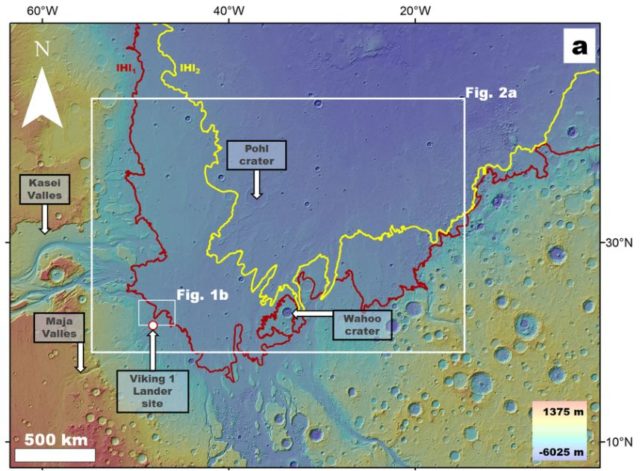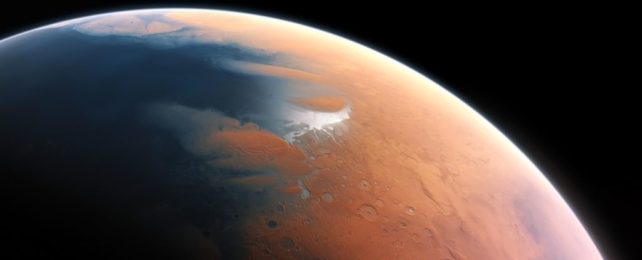Multiple lines of evidence suggest that Mars wasn't always the desiccated dustbowl it is today.
In fact, the red planet was once so wet and sloshy that a megatsunami was unleashed, crashing across the landscape like watery doom. What caused this devastation? According to new research, a giant asteroid impact, comparable to Earth's Chicxulub impact 66 million years ago – the one that killed the dinosaurs.
Researchers led by planetary scientist Alexis Rodriguez of the Planetary Science Institute in Arizona have located an enormous impact crater that, they say, is the most likely origin yet of the mystery wave.
They named it Pohl and located it within an area scoured with catastrophic flood erosion, which was first identified in the 1970s, on what could be the edge of an ancient ocean.
When NASA's Viking 1 probe landed on Mars in 1976, near a large flood channel system called Maja Valles, it found something strange: not the features expected of a landscape transformed by a megaflood, but a boulder-strewn plain.
A team of scientists led by Rodriguez determined in a 2016 paper that this was the result of tsunami waves, extensively resurfacing the shoreline of an ancient Martian ocean.
At that time, they hypothesized that two tsunamis were triggered by separate impact events, 3.4 and 3 billion years ago. Numerical simulations led scientists to the Lomonsov crater as the source of the later tsunami.
However, the source of the earlier tsunami remained elusive. The northern plains in which a Martian ocean is thought to have once sloshed is heavily cratered and challenging to interpret. Rodriguez and his team painstakingly combed maps of the Mars surface, looking for impact craters that could be linked to huge tsunamis.
They hit upon Pohl, located some 900 kilometers (560 miles) northeast of the Viking 1 landing site, a crater 110 kilometers across, sitting around 120 meters (394 feet) below what scientists believe would have been sea level, in a region called the Chryse Planitia.

Based on rocks around the crater that had been previously dated to around 3.4 billion years ago, the researchers thought that Pohl, too, may have formed at this time. And its position near flood-eroded surfaces and hypothesized megatsunami deposits suggest that the crater formed during a marine impact.
To confirm their suspicions, the researchers conducted impact simulations, tweaking the parameters of the impactor and the surface that it slammed into. They found two scenarios fit the observed site.
First, an asteroid 9 kilometers (5.6 miles) across encountering strong ground resistance, resulting in a 13 million-megaton explosion. The other scenario was an asteroid 3 kilometers across encountering weak ground resistance, releasing 0.5 million megatons of TNT energy.
In the simulations, both of these scenarios resulted in a crater 110 kilometers across, unleashing a megatsunami that traveled as far as 1,500 kilometers from the impact site – easily covering the region around Maja Valles.
The simulations also matched the boulder-strewn landscape as ejecta from the impact was carried and deposited by the tsunami, which in the case of the 3-kilometer asteroid, reached a height of 250 meters.
"Our simulated impact-generated megatsunami run-ups closely match the mapped older megatsunami deposit's margins and predict fronts reaching the Viking 1 landing site," the researchers write.
"The site's location along a highland-facing lobe aligned to erosional grooves supports a megatsunami origin."
The site is analogous to the Chicxulub impact, the researchers said.
Both occurred in a shallow marine environment, created a similarly sized temporary cavity in the ground, and (according to simulations) generated a tsunami exceeding 200 meters in height.
"Our findings," they write, "allow that rocks and soil salts at the landing site are of marine origin, inviting the scientific reconsideration of information gathered from the first in-situ measurements on Mars."
The research has been published in Scientific Reports.
